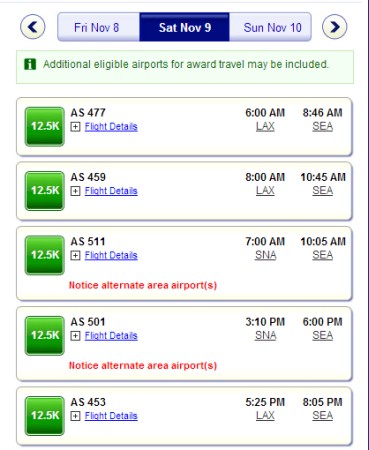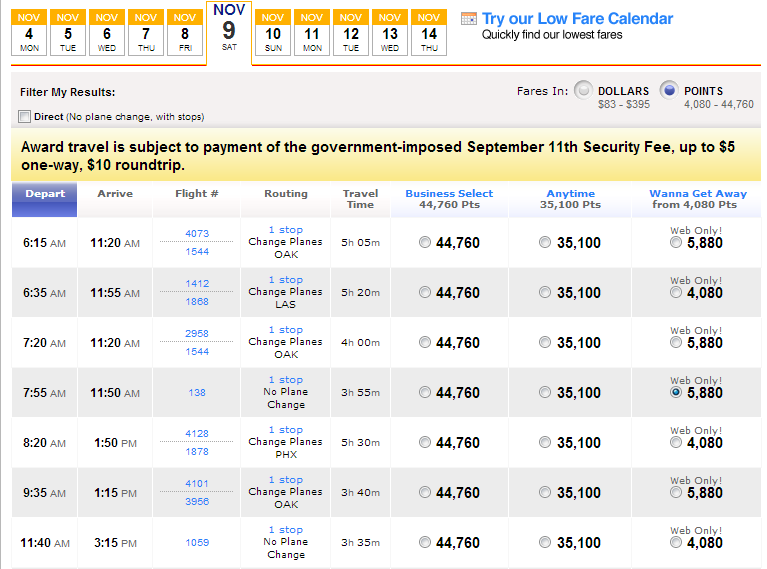Perception drives how you view the above image. If you’re an optimist you view the glass as half full, a pessimist as half empty. Deciding which flights to take, and which miles to use is a lot like the above discussion of the glass half-full, or half-empty, ask 5 people, you’ll likely get 5 different answers. Today we’ll try to put some hard numbers to these tough to pin down details, and in doing so discuss trading time for Miles.
As I mentioned I’ll be in Seattle in a few weeks. In looking for flights I’ll be using the hybrid system to end up with two trips for the price of one and a half.
The Search: LAX-SEA with BA miles or WN points?
My wife and I are looking to fly out November 9th in the morning and arrive no later than 1ish in Seattle. The options we’re looking at are either flying AS with BA Avios, or Southwest with RR points.
For AS low level flights, as I mentioned in the post “The Best Way to Search for Low Level Domest Award flights,” I actually prefer to use the AA search engine over the Alaska site, because AA will only show low level AS awards–and I can filter by non-stops, bookable with BA at the 7500 avios level.

A similar search could be done on www.alaskaair.com, however I like the fact that AA.com keeps mid and high level awards from cluttering the screen. Also clicking on flight details to see duration, type of aircraft and such is easier on AA.com as it doesn’t interrupt your search as much as it does on www.alaskaair.com. You’ll find the same flights on either site, but remember that www.alaskaair.com will show you Delta flights that aren’t bookable with Avios.
The search was easy enough, and there’s a good nonstop option, leaving LAX at 8am and arriving at 10:45. This would be bookable with 7,500 Avios plus $2.50 each. 15,000 avios plus $5. Fortunately I’ve transferred some avios speculatively during a 30% MR bonus, so this flight is costing me about 12,000 MR for the two of us, plus $5.
Southwest’s search is, as always, done on www.southwest.com. There are plenty of WGA fares still available, so our best use of points would be there. Take a look at our options below:

There are a couple of options that get us in before or around 1PM. Of them lets look at two options: the 4,080 point redemption that leaves at 8:20 am and arrives at 1:50 pm, and the 5,880 point redemption that leaves at 7:55 and arrives at 11:50 am.
I’m going to use these two flights, and our reference flight on AS with 7,500 Avios to illustrate the idea of today’s post. If you remember back to the post “when Less is More,” an important step to do before booking is to calculate out what the cost of each option will be based on your mileage costs.
- – Alaska Flight: 12,000 MR plus $10 (15,000 BA Avios), each MR is costing me a consistent $.013 to earn, which means each Avios is costing me .01 after the 30% transfer bonus I took advantage of. Either way you calculate this is $156 +5, for a total of $161.
- -WN Flights: First option: 4,080 points per person for a total of 8,160 at $.012 per = 97.92 + $5= 102.92.
- – WN Second Option: 5880 points per person, 11,760 total at my cost $.012 = 141.12 + $5 = $146.12.
This might seem easy–the First WN option is the least number of points. But there’s another important piece of the puzzle here that we’ve discussed before in Milenomics: Your Time.
Don’t Forget to Add in Your Time
We have our mileage costs set here now, and the option that looks the best is the southwest flight for 4,080 points per person (total cost for two of us $102.92). However I want you to look at the time spent on each flight.
- Alaska Flight: 2hrs 45min
- Southwest Option 1: 5hrs 30min
- Southwest Option 2: 3 Hrs 55min
5:30 minutes is exactly double the amount of time as the Alaska Direct flight. Remember my T-Rate is $25 an hour, but my wife’s is $50 an hour, so we’ll use her T-Rate since it represents the boss coefficient.
Additional Time Value of each option:
- Alaska Flight: $0, shortest option
- WN option 1: $137.50 in extra time x 2 of us = $275.00
- WN Option 2: $58.33 in extra time x 2 of us = $116.67
Again these are my values, yours could be much lower–or even $0 if you want to fly as much as possible for the absolute minimum miles. If you Have a Southwest companion pass things get harder too, because your time value will be the same, but your cost in miles will be halved.
Are you Buying Time with Miles? Or Miles with Time?
In the above example my wife and I are booking the AS flight–the difference in Miles is not enough to justify either WN flight. You could look at it as we’re trading miles for Time. This is a rather short flight, which costs very few miles/points, so the example isn’t as dramatic as a long international flight where the time and miles could really start to stack up–but the idea is the same. It is important to start to use these techniques on these shorter flights to practice for when you start booking longer, more complex flights.
I’m spending an additional $58 (5,800 avios) in miles to save myself 2hrs and 45minutes worth of flying, waiting to board, possible misconnects, etc. The opposing viewpoint of this is that if you take the Southwest option #1, you’re saving 5800 Avios for your 2 hr and 45 minutes worth of extra travel. Which way do you see it? The answer is usually that it depends on what your T-Rate is, and how you value your time.
I’d definitely fly the shorter WN option (#2) if my T-Rate were lower and I had a CP. With a Companion pass the points would only be 5,880 WN RR ($75.56). If Our combined T-Rate were only $25 an hour that would be $58 in time–for a total of $133.56. I’m saving 8,044 ($80.44) in Avios and $27.44 overall. In this case I’d be trading my time for Miles. Would I ever take Southwest Option #1–probably not, the routing itself seems so bad:
Even within one program you’re often deciding between trading time & money. Assume you didn’t have any Avios and only had RR points. The two options above are 3600 miles less for both of us if we take the longer option. You’re trading 3600 RR points for 1hr 35min less time flying. Or you’re trading 1:35 of time for 3600 RR. Depending on your values for each RR point and you T-Rate you’ll either see this as an opportunity to trade miles for time, or time for miles.
Remember: Your Numbers Are the Only Ones That Count
The above examples use my mileage costs, and T-Rates. It is not an example of what you should do. It is an example of how Milenomics approaches this situation. It is really an academic example–there are probably those of you who would just buy this ticket with cash ($109 or so per person, $218 total). I could see that being the case if: your Avios cost you more than $.015 per, you didn’t take advantage of a 30% MR transfer or if you’re short on Avios and have an upcoming expensive trip that you’ll need them for (similar to the Leapfrog method of booking). But one thing Milenomics stresses is that we really should be using our miles whenever we can.
When it comes down to it, Milenomics puts numbers to things that are somewhat hard to quantify. Sure the allure of using less miles is always enticing. Whichever way you see the problem, make sure you’re buying time with miles (or miles with your time) at a rate that makes sense for you.[rule]




Great post – seems like people often undervalue their time when trying to figure out redemption plans
I really enjoy this type of discussion. I value my time at different monetary amounts depending on what else I could be doing with that time. In other words, if the difference is arriving at 10pm or 11pm, when all I’d otherwise be doing is sleeping, I’d rather get the cost savings. But if that’s more usable time (whether for touring or being productive back at home), I’d use a different dollar factor in my equation and probably pay more to get the time savings.
OOh…I like it… a variable T-Rate. As you can tell I love coming up with new names for things. 😉 I agree with you– for me there’s a big difference between waking up at 3:30am for a 6am flight and waking up at a normal time and catching a flight at a more regular hour– in that instance my T-Rate approaches ∞. The takeaway is to always give your time a value, and include that in your calculations. So many times I’ve been kicking myself for spending more miles thinking I got ripped off–after including a T-Rate I feel much more at ease with my booking decisions.
Great post indeed!
Great post